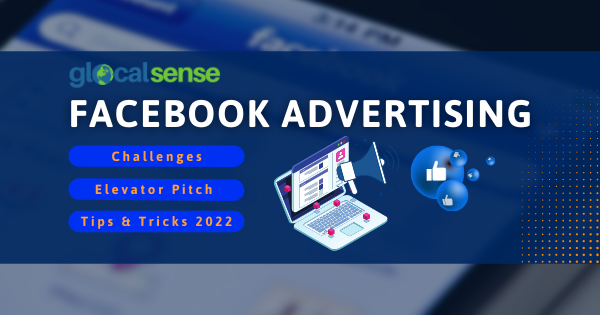We all are aware of Facebook and its evolution on the internet today. But are we aware of how to get the most value for the money with Facebook advertising?
We have become so used to surfing through Facebook and seeing Ads that we almost don’t notice them. Yet, these Ads are a powerful tool for marketers. So how can you put Facebook Ads to work for your company and see a good return on investment?
Facebook Ads that run exclusively through Facebook’s advertising platform can appear on your Facebook feed, Messenger, and even non-Facebook apps and websites. They are available in various formats, including single images, videos, slideshows, and more, and are tailored to cater to specific audiences.
Creating a Facebook ad is not the same as posting on your page. Everything about Facebook Ads is developed from the keyword, which we regularly use as a search term that aids in navigating users to a site.
What are Facebook Ads?
Facebook Ads are considered paid messages that businesses place on social media platforms. The term “paid” is the most important part of this definition. Anyone can post for free on their Facebook profile, but you never know who will view it.
You can target a specific demographic with a paid ad, and you can be as exact or as broad as you like.
Facebook ad campaigns are available in various formats. You can get to specify how much you want to spend, including:
• The overall amount
• Your daily budget
• Your cost per result
You may even choose which user activity you’d like to pay for. That doesn’t mean Facebook will only charge you if your ad performs as expected, but you may choose how you want to be billed, such as the number of views or clicks. Depending on the objectives you set for your ad, you have various options.
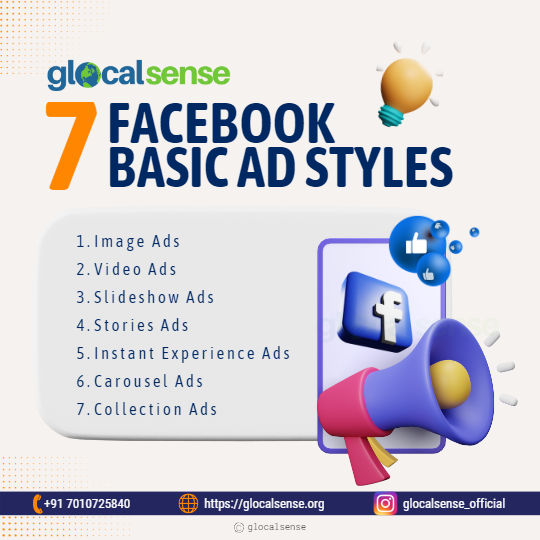
There are seven basic ad styles, but you may create a wide variety of ad types aimed at various advertising goals using these seven. Here are the seven main ad formats before diving into the many sub-types you can create with them.
1. Image Ads
2. Video Ads
3. Slideshow Ads
4. Stories Ads
5. Instant Experience Ads
6. Carousel Ads
7. Collection Ads
The Benefits of Facebook Ads: Reasons Why You Need Them
Do you ever wonder if the Facebook Ads in your news feed are genuinely effective? In some cases, they turn out to be unpleasant and inconvenient at times. Yet, they may do miracles, and if you’re a business owner, you should consider partaking since you could benefit greatly.
But what are the advantages of Facebook Ads?
Facebook Ads could aid E-Mail marketing, web presence, SEO, and organic social media. If you publish a targeted ad on the network, your chances of reaching them increase dramatically. Because organic Facebook traffic is almost non-existent, this is necessary.
So, here are some best practices and benefits of Facebook Ads.
Facebook Ads best practices
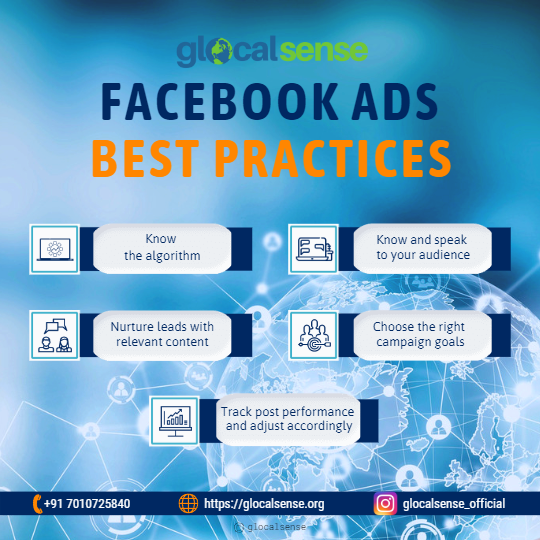
You need to know what Facebook likes to see in user behavior to get the most out of your Facebook Ads. Best practices can help you rank higher and get more people to see your ad.
• Know the algorithm
• Know and speak to your audience
• Nurture leads with relevant content
• Choose the right campaign goals
• Track post performance and adjust accordingly
Facebook has been one of the world’s most popular marketing platforms. As the social media giant has grown to over 2.7 billion active members, it has expanded its ad network to accommodate a wide spectrum of many businesses.
While there are many benefits of Facebook advertising, a few are not; paid advertising does come with a slew of difficulties.
Before you can comprehend how Facebook can help you reach new audiences, you must first understand what it offers businesses and how its paid ad network is built to provide various advertising options.
Facebook’s advertising model is supported by the omnipresent “pay-per-click” strategy, which has become the most widely used system for online advertising. PPC is vital for the same reasons that Facebook advertising is affordable, effective, and fast.
The benefits of Facebook Ads and the reasons why to use them are:
• Micro-target your exact audiences
• Highest retail Return on Advertising Spend (ROAS) for any social platform
• Affordable and low cost (set your budget)
• Facebook Ads offer for your specific business goals
• Better ad types for your business needs
• Access to powerful, in-depth data
• Facebook pay-per-click Ads are simple to set up.
• Ad forecasting and performance estimates
• Facebook Ads can give results very fast
• Provides access to the world’s largest audiences
• A/B ad testing for performance growth
• Filter Ads for excluding people you don’t want to see them
• Sponsored messages offer powerful benefits
• They give better content marketing results
• Facebook Ads remarketing
How to create a Facebook Ads Manager account
You must use Facebook’s Ads Manager tool to create and monitor your Ads. The setup process is simple. Facebook will redirect to your Ads Manager page when you agree to its non-discrimination policy.
Select a campaign goal and create your first ad there. The aim you select is used to direct the creation of your ad set, which tells Facebook how to post your ad. Next, you’ll specify your preferences for:
• Demographics of the audience
• Schedule of the post
• What you are willing to pay per ad display, per day, and on an annual basis
Top Facebook Advertising Trends for 2022
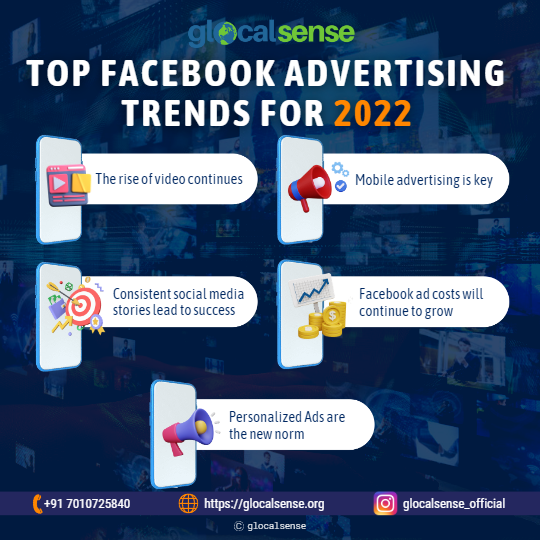
Since Facebook has one of the largest and most diverse audiences on the internet, it has long been a cornerstone of modern online marketing strategy. As a result, marketers who can successfully reach even a small portion of that population will significantly increase revenue.
However, if there is one constant on the platform, trends change yearly. What worked last year may not work again this year; as a result, in the competitive digital world, marketers must keep their eyes and ears alert to stay one step ahead of their competition.
Let’s look at which trends will continue to be important for Facebook marketers in 2022. The lessons learned in 2021 are still fresh in our memories.
In 2022, there are five Facebook ad trends that marketers should be aware of.
1. The rise of video continues.
Video now accounts for more than half of Facebook users’ time, ranging from simple slideshows to traditional commercial-style advertising. It’s also worth mentioning that Facebook has made each video in a feed soundless by default, so you’ll need to add words to go with the images to convey your point. Small things like this distinguish the pros from the amateurs on the platform, so make sure your video strategy reflects this.
2. Mobile advertising is key
Advertisers should take extra care to target the unique needs of mobile consumers, as mobile platforms have long held an advantage over desktop and diminishing tablet usage.
98.5 percent of Facebook users use a mobile device to access the platform. Because of this astounding number, advertisers that generally work on desktops must ensure that their Ads fit and perform best for a mobile audience first and foremost.
3. Consistent social media stories lead to success
Instagram and Facebook have been following suit for quite some time. Facebook stories are used by 300 million individuals every day. The potential to turn this attention into profit is enticing.
Stories can be used in Facebook Ads to increase engagement.
Successful ad copy or a popular topic can be reflected in stories, with some even linking directly to them. Interested Facebook users can navigate your website, resulting in conversion if all goes well.
4. Facebook ad costs will continue to grow
Facebook has over a billion users and appears to have an infinite number of features. Still, it’s an expensive game to play for advertising these days. Despite wide variations, the average cost per click (CPC) hovers around $1.72.
However, start-ups and small businesses with limited capital reserves will need to take further steps to assure a reasonable return or find alternative venues to advertise on.
5. Personalized Ads are the new norm
Businesses that use some form of personalization in their advertising will experience a far higher return on investment in terms of effectiveness. 80% of customers say they are more inclined to buy if marketing efforts are tailored to their needs.
It requires including the prospect’s name in the header and making a list of products and services that match the customer’s profile. After that, it all comes down to anticipating and predicting a customer’s needs, making the conversion process as simple as possible.
Significance of staying on top of Facebook ad trends
Businesses that recognize and comprehend Facebook ad trends have an opportunity to profit before their competitors catch up and adapt. In today’s advertising world, speed and efficiency are essential, so keep an eye out for which trends are fading and which ones are the rising stars.
What’s the ‘Elevator Pitch’ Facebook Ad Strategy?
An elevator pitch defines a product, service, or organization quickly and its value proposition. It can be the most simple and effective marketing tool for a small business owner.
Your elevator pitch aims to keep it short and sweet to entice your potential client to learn more about your company. The time can vary, but you should be able to give your elevator pitch in 30 seconds or less without being rushed.
Tips to Effective Elevator Pitches for Facebook Ads:
A good elevator pitch has a key that has to do with sales and marketing psychology. Here are a few things to remember:
1. Know Your Audience
Get your lead to talk first to learn more about them and their problems so you can adjust your pitch to their requirements.
2. Less Is More
It’s normal to want to convey everything about your business. Still, if you go into monologue mode, you risk boring or upsetting your lead. So instead, be concise and include information that will entice your lead to enquire about your company. Again, describing your advantages rather than your features will help here.
3. Consider Leading with a Hook
A hook is a message that potential consumers or customers view before becoming actual customers. It’s the thing that entices their interest and draws them in. It’s the fundamental motivation for consumers to accept your offer.
That first line, which is the prospects’ first point of contact with you, must be so compelling that they feel compelled to read all the way through. They then perform what you ask them to do next in your call to action: either give up the contact information (become a lead) or put down their credit card and purchase (become a customer).
4. Create Opportunity for Follow Up
You should be able to follow up on any marketing you do. The follow-ups could be a call-to-action where your lead is asked to take the next step. Get your lead’s details and boost your chances of a further follow-up.
5. Practice, Practice, Practice
Don’t just write and read your elevator pitch; practice saying it aloud. If it doesn’t sound natural when you say it, you’ll come across as a salesman. When the chance arises, you want your pitch to flow as a natural part of the conversation. If you’re having trouble flowing through the pitch, rewrite it till it’s easy to say.
Like a business card, an elevator pitch is a quick and easy method to introduce your business to new individuals. You want to use your pitch to generate interest in your company and convert a lead into a prospect.
Top 10 Facebook Advertising Challenges
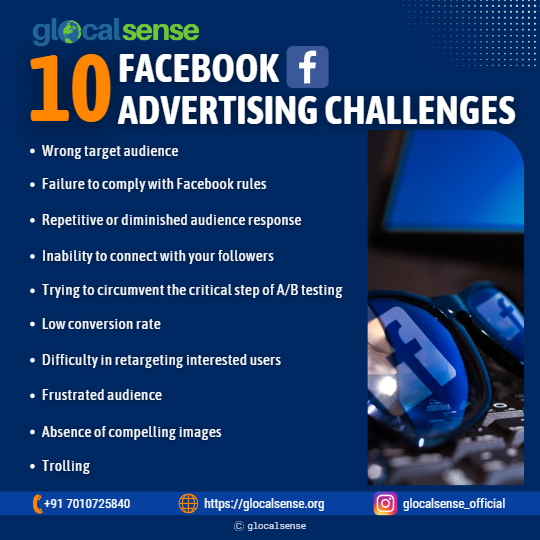
To acquire the right engagement and CPC on Facebook advertising, you must learn how to market and advertise your products and services effectively. These are some of the top 10 Facebook Advertising Challenges.
1. Wrong target audience
2. Failure to comply with Facebook rules
3. Repetitive or diminished audience response
4. Inability to connect with your followers
5. Trying to circumvent the critical step of A/B testing
6. Low conversion rate
7. Difficulty in retargeting interested users
8. Frustrated audience
9. Absence of compelling images
10. Trolling
7 Tips on Building Effective Facebook Ads in 2022
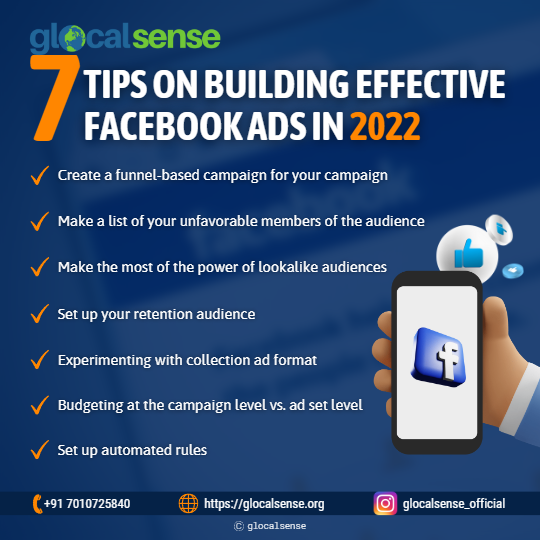
Facebook Ads are an excellent way to reach out to your target audience and increase sales. However, the most challenging aspect of Facebook Ads is getting them to function. You’ve put a lot of effort and money into developing an ad, but the results are underwhelming.
We want to share some tips to help the customers get the most out of their ad spend. So do follow these practical seven tips to build your business online.
Tip #1: Create a funnel-based campaign for your campaign.
Setting up your campaign based on your funnel is a better way to go. It helps you better understand the performance of your campaigns at different funnel phases. Most importantly, you may establish multiple offers for a single campaign at the ad level, enabling Facebook’s algorithm to determine which offer (ad) will resonate most with your target audiences, resulting in more significant results.
Tip #2: Make a list of your unfavorable members of the audience.
Setting up a negative audience list on Facebook Groups is critical for increasing the relevancy of your ad by excluding specific audiences at various funnel phases. The following is a suggested negative audience list for you to create:
• Existing Customers
• Social Engagers
• Website Visitors
Tip #3: Make the most of the power of lookalike audiences.
Using lookalike audiences is a great approach to broaden your audience and attract new customers. We recommend uploading those loyal and promising client lists and establishing a lookalike audience based on them if you have a large enough customer base. Customers with a high purchase frequency and AOV (Average Order Value) usually fall under this category. We increased the AOV by more than 40% by targeting this similar audience.
Tip #4: Set up your retention audience
Your current customers are your lifeblood, and you should do all in your power to keep them satisfied. Setting up a retention audience is one approach to do this. You can target customers who bought something on your website in the last 180 days or between 60 and 180 days by creating a retention audience.
Retaining an audience is an excellent technique for reconnecting with existing clients and guaranteeing that they don’t forget about you. In addition, you can send targeted Facebook advertising to this demographic, such as special deals or new arrivals.
Tip #5: Experimenting with Collection ad format
The collection ad format is a new Facebook ad type that allows your audience to quickly discover and browse your product catalog by simply tapping the ad while enjoying a fast-loading experience.
Creating a collection format will benefit you if you have a lot of products available for your customers to buy. In addition, the collection ad type appears to outperform other ad formats in all funnel stages.
Tip #6: Budgeting at the campaign level vs. ad set level
In most cases, the acquisition funnel campaign will receive around 70% of your ad budget. Thus your goal should be to optimize the “Return On Advertising Spend (ROAS)” as much as feasible. Instead of outsmarting the Facebook algorithm by telling it how much to spend on specific audiences by setting the budget at the ad set level, we strongly advise setting your acquisition campaign budget at the campaign level.
However, setting your budget at the ad set level is recommended if your goal is to see which audiences will provide you the best results in the Retention or Retargeting funnels. As a result, you may run A/B tests on the ad sets to see which audience performs better.
Tip #7: Set up automated rules
When it comes to Facebook Ads, many businesses overlook this option. However, when it comes to managing your Facebook Ads, the ability to create automated rules can save you a significant amount of time and effort.
With the correct pro-tips, you’ll be able to create effective ads that reach your target audience on Facebook Ads. So when planning your next Facebook ad campaign, keep these pointers in mind.
Create audiences and campaigns in advance for more accurate estimations and provide plenty of time for testing, whether you’re establishing Facebook Ads campaigns for the holidays or fine-tuning a strategy for 2022.
Your Facebook ad campaigns may require additional manual adjustments and optimizations in the future. But suppose you plan carefully, pay attention to the platform’s recommendations, and watch campaign results closely. In that case, you’ll have a much better chance of getting the results you want.
